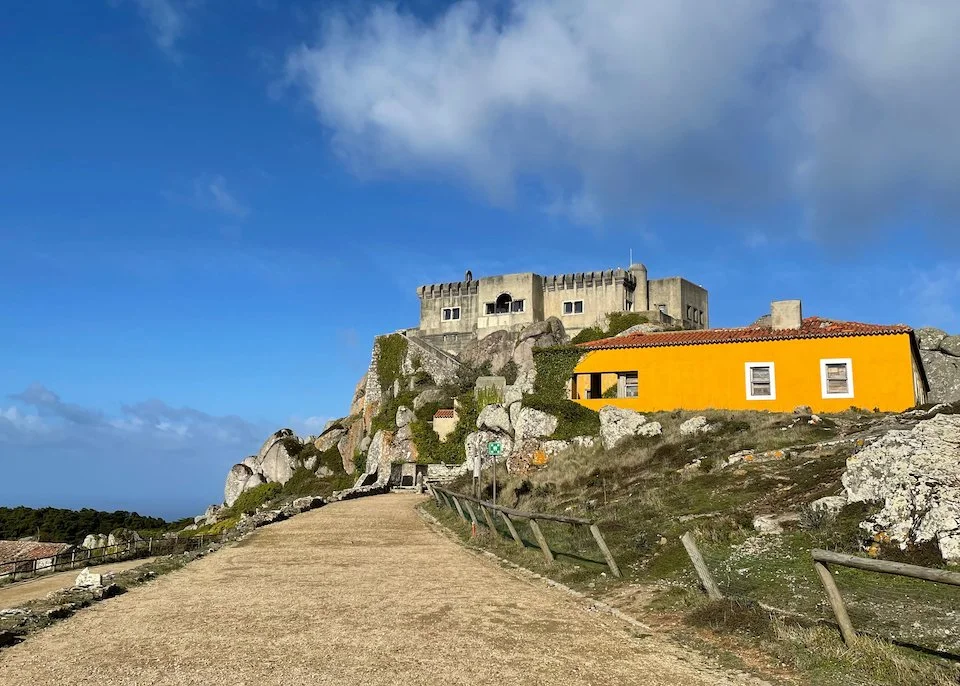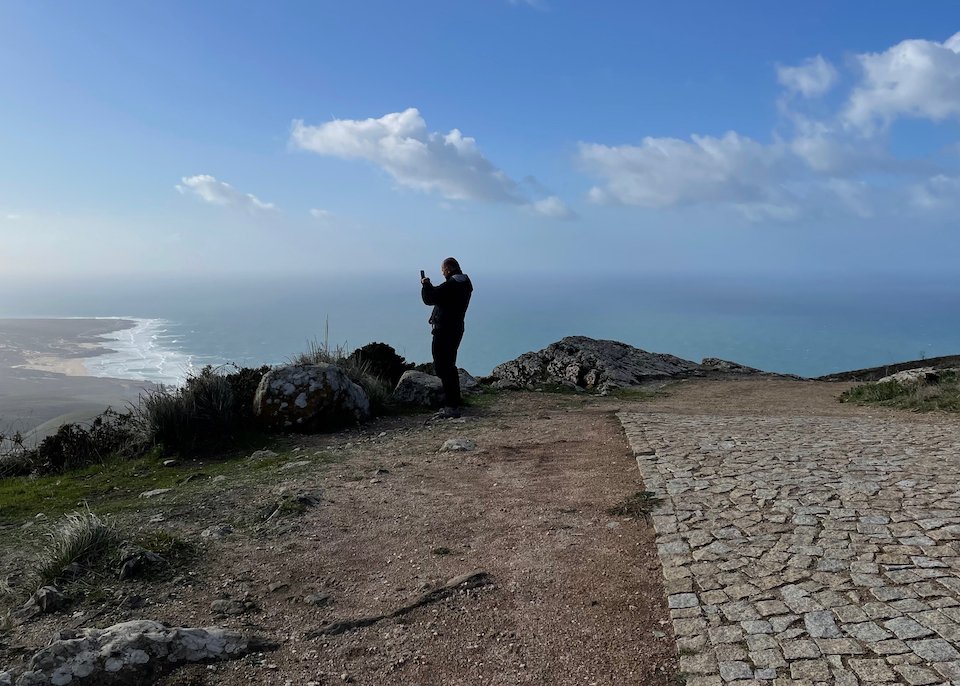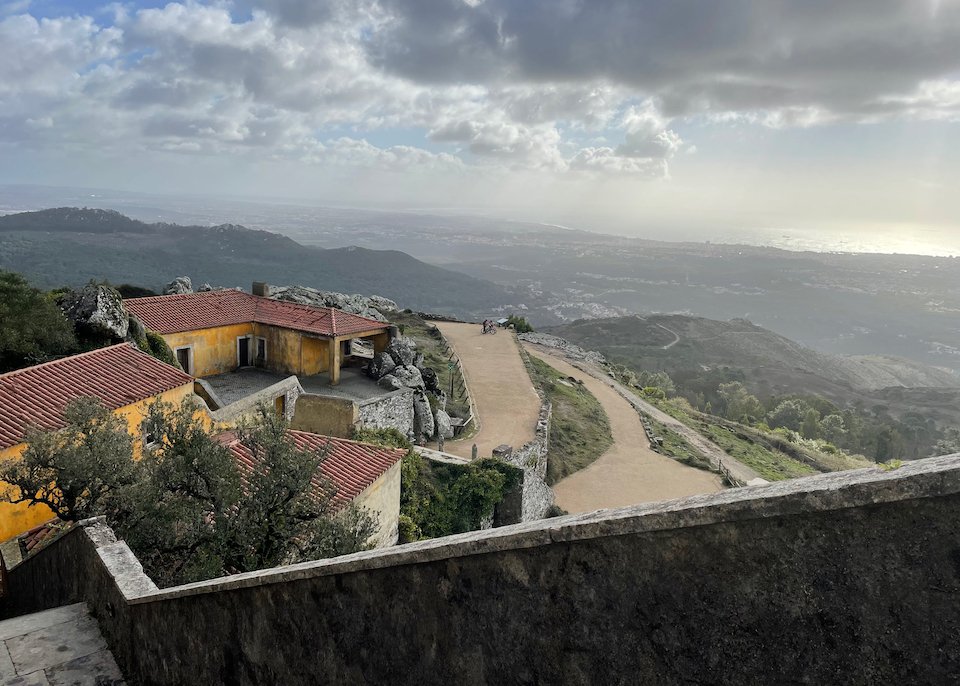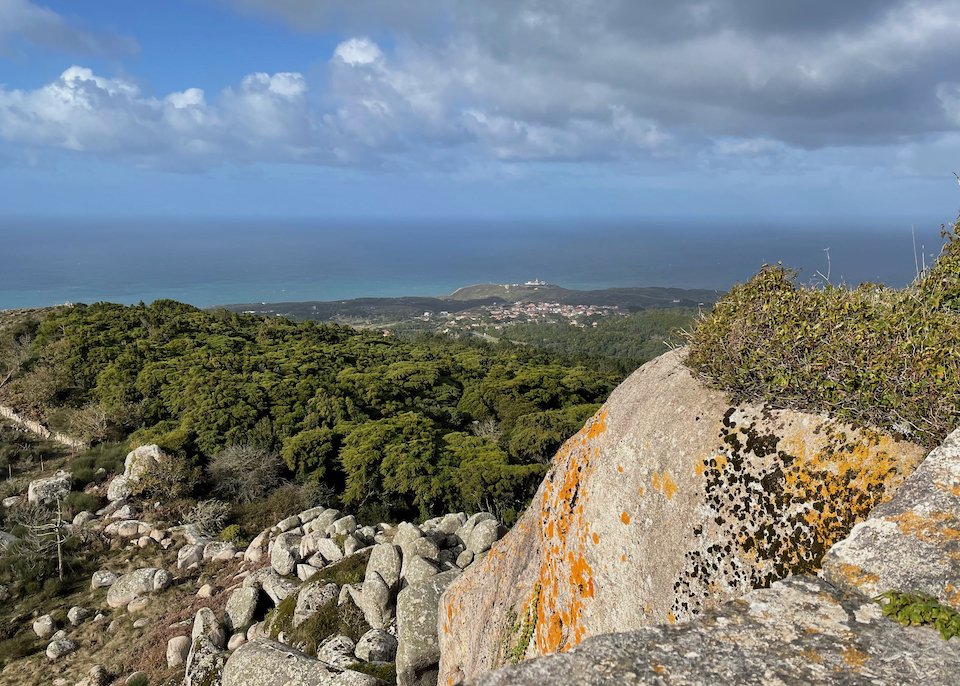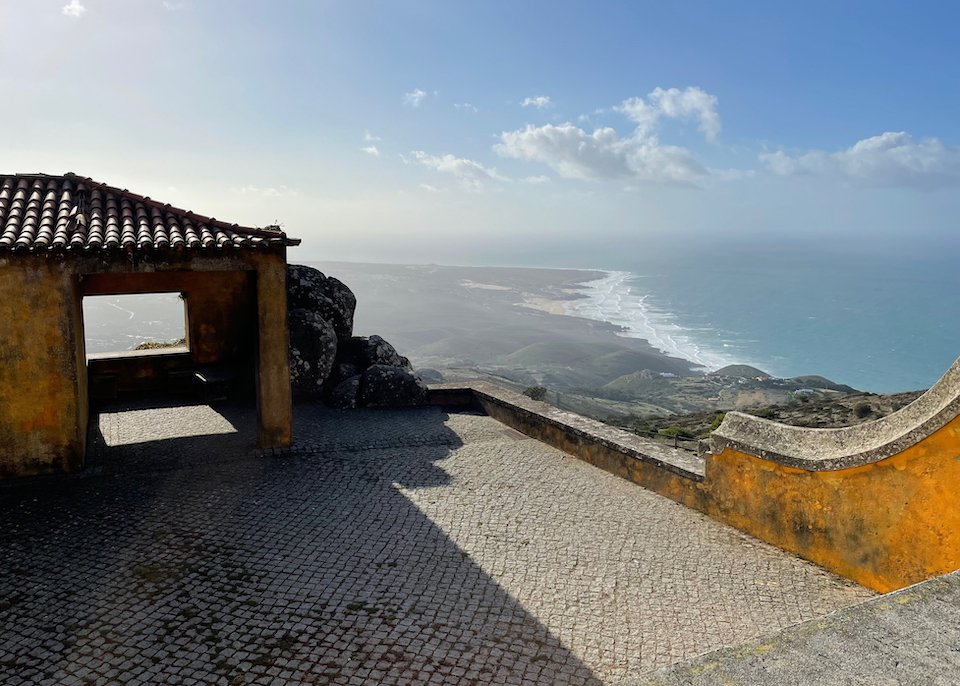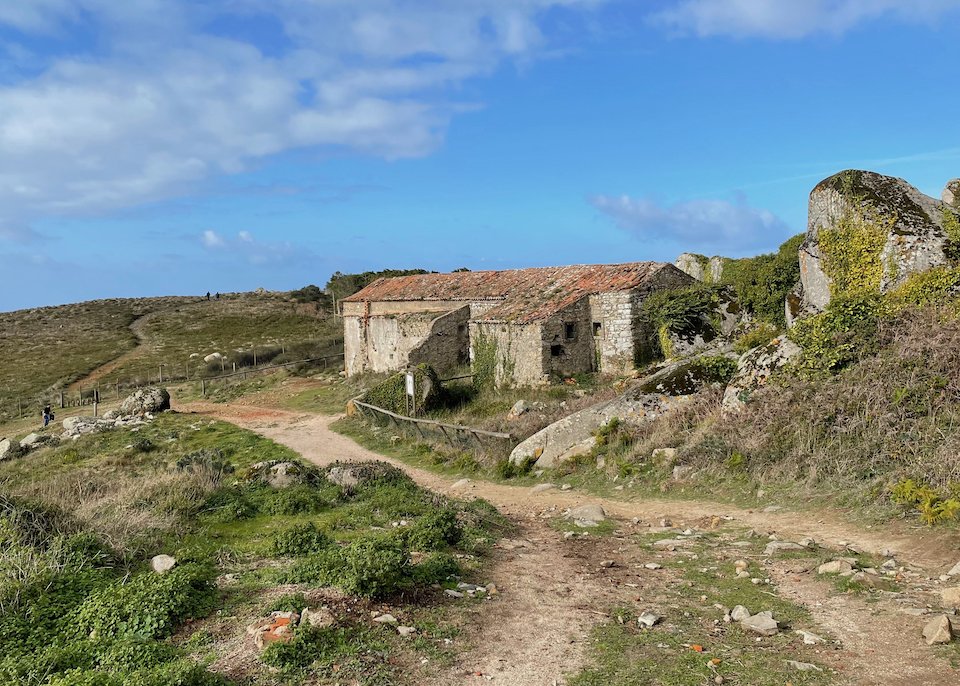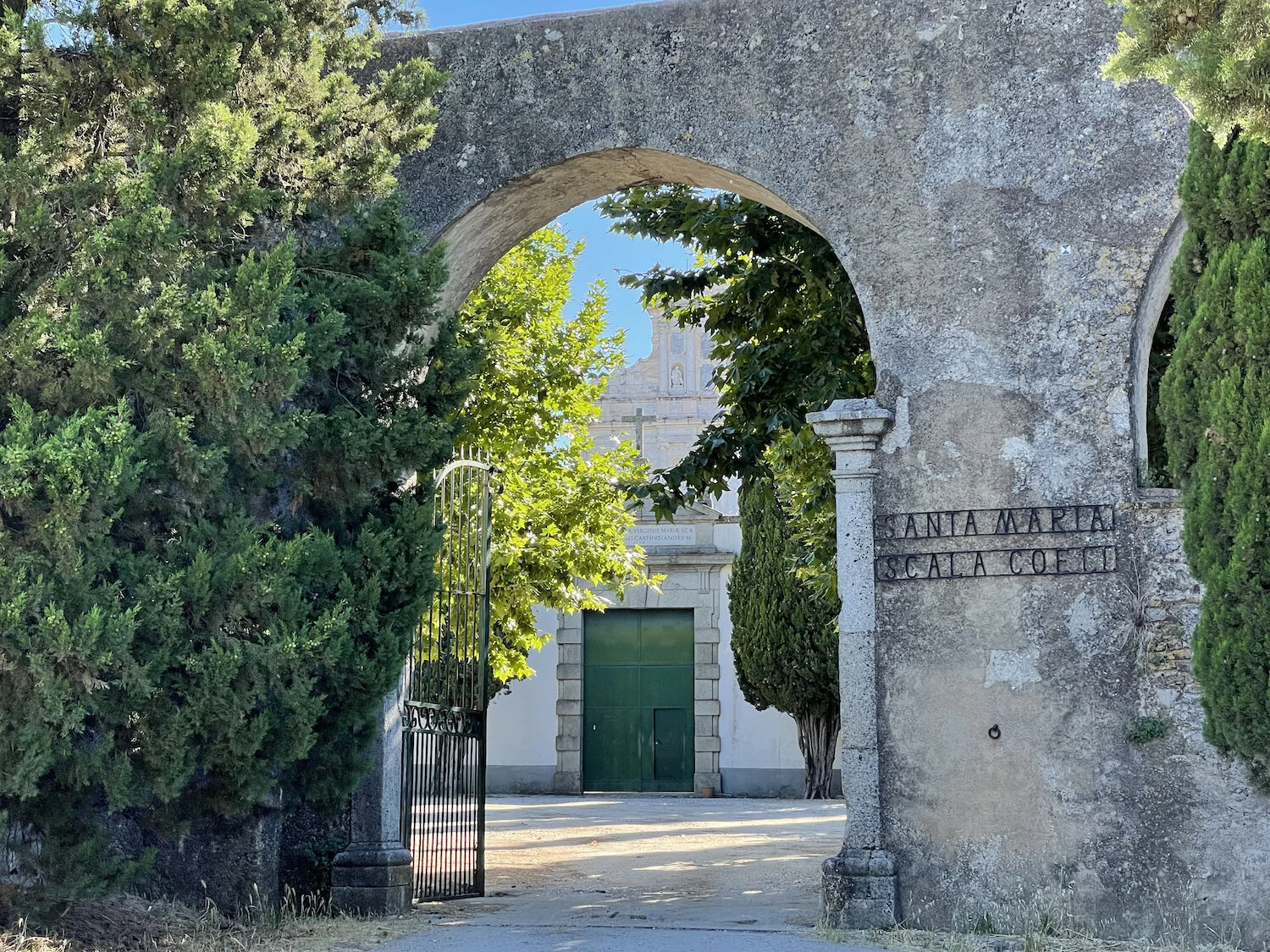Miracles at Our Lady of Peninha
By Elyn Aviva
The breeze brushed across my face as I walked up the path toward the Portuguese Sanctuary of Our Lady of Peninha. The chapel is perched at the top of the most western of several hard-to-reach hilltops on the Serra da Sintra, a granite massif that stretches 16 kms east to west until it drops down into the Atlantic. In the distance I could see a jumbled group of buildings perched on a mass of jagged granite boulders that pointed like giant shark’s teeth up toward the heavens.
A battered sign explained that the Sanctuary of Nossa Senhora da Peninha was built to commemorate the 16th-century apparition of the Virgin Mary, who appeared to a mute young shepherd/ess who had lost his/her sheep. Miracles ensued, including a recovered sheep, a regained voice, and bountiful bread. Soon, nearby villagers built a shrine, and the place became a pilgrimage site. In 1711, a larger, more impressive chapel was completed.
My route to the sanctuary led by a lookout spot. A man was standing nearby, taking photos of the coast and talking into his cellphone in Portuguese. I walked on. I don’t like heights, and one glance at the scenic overlook revealed how high above the distant coastline I already was.
The wide path led up the hill to several lemon-yellow buildings that seemed to grow organically out of the surrounding rocks. These were pilgrimage shelters, built when the sanctuary was a popular destination for sailors and their families, a place to pray for their safety and a vantage point to watch for ships returning.
A large grey building resembling a fortified castle was visible on the hilltop above. I wondered if it was the chapel or whether it was the private (and never completed) mansion built on the hilltop in the early 20th century by António Augusto Carvalho Monteiro. He was a very wealthy man, steeped in esoteric traditions, who had built the enigmatic Quinta da Regaleira estate in nearby Sintra.
As I approached the yellow buildings, I suddenly started shaking. I was surprised by my reaction. I don’t like heights, but usually I don’t start to tremble unless I’m staring out over a precipice. It’s true there was quite an imposing view of the distant, far-away landscape and the coast far below, but usually that doesn’t trigger my acrophobia.
I heard voices and turned around. “Photo-man” was talking with my husband, Gary, asking what this place was called. How curious, I thought. This is not a place you arrive at by accident. You have to drive a circuitous route on a narrow winding road through the Sintra-Cascais Natural Park to reach the gated entry to the sanctuary. How could he not know where he was?
I ignored them and continued walking up the walkway that led to the large grey building at the top of the penha (Portuguese for hilltop; Peninha is a small hilltop).
The walkway quickly turned into a broad staircase, supported on the left by a 4-foot-high wall; on the right was upright granite bedrock and a retaining wall. My legs trembled as I climbed. I was sheltered, protected by walls on both sides. And still I trembled. Not only that, I was terrified. This is totally ridiculous, I thought. What else could be making me so shaky? The energy of the sea and wind? The energy of the huge granite outcrop? I paused, putting my hand on the foundation wall to steady myself.
“Photo-man” came jogging up the stairs and saw me standing there, trembling, breathing fast.
“Are you all right?” he asked.
I nodded but explained, “I’m afraid of heights.”
He looked thoughtful. “Try grounding yourself, feeling your feet on the stairs.”
“I tried. It didn’t help.”
“Have you tried pushing your limits a little?”
I nodded. “Many times. I’ve tried hypnosis, de-sensitization conditioning. Nothing helps. Maybe I was thrown off a hillside in a past life!”
“Ah,” he said, thoughtfully. “I’m a paraglider—I’ve never had that problem.”
As I forced myself to climb the stairs, taking each step slowly, he walked beside me. I asked where he was from, and he said Brazil, but he had lived in Miami at some point, so he spoke excellent English. Now he was visiting Portugal.
As we walked together up the staircase, he asked, “Is there anything more I can do to help?”
I thought a moment. “Yes, in fact, there is. I want to know if you can see the Cabo da Roca lighthouse from the top. Could you go on ahead and let me know?”
I had had a vision in meditation of myself, sitting on top of a hilltop, looking out to Cabo da Roca, the most western point of land in Europe. I wondered if this hilltop was the place that I had seen. If I could see the Cabo from the sanctuary, I would compel myself to continue, even though my legs were quivering like jelly and I was terrified.
Fearless and fit, “Photo-man” bounded up the stairs and leaned over the retaining wall. He called out, “Yes you can!” And hurried back to my side.
I sighed. “I’ve got to get there, then.” After all, I’d been gifted with a vision. The least I could do was face my fears and see if this was the place I’d seen.
My right hand pressing against the rock wall, “Photo-man” beside me, I managed to make it to the paved courtyard in front of the grey castle-like building. The gentle breeze turned into a forceful wind, blowing for thousands of miles across the ocean until it encountered its first obstacle: me. I saw there was another, smaller building attached to the first. This was the Chapel of Our Lady of Peninha, identifiable by a small cross perched on its gable. Its battered, graffiti-covered door was locked.
With the encouragement of my newfound nameless friend, I edged my way across the courtyard to the parapet and looked down and out. The scene was stunning. I could see the waves pounding on beaches far below; I could see the Cabo lighthouse; and I could see the Atlantic stretching into the distance until it blended into the sky.
I looked around and knew that this was not the view I had seen in meditation. I was proud that I had managed to get here, despite my terror, and turned to thank “Photo-man.” He had disappeared.
The courtyard started to get crowded. A touring group of cyclists had arrived and were eagerly taking selfies. Still shaking, still trembling, I slowly walked down the stairs, this time with my left hand pressed against the stone wall.
Below the sanctuary and the pilgrims’ shelters, on more level land, is a decrepit 16th-century hermitage, built over a 12th-century hermitage dedicated to San Saturnino. I took a shortcut to get there, and as I scrambled down the steep, rocky trail, “Photo-man” was suddenly at my side, helping me with his outstretched hand. And then he was gone again.
Inside the hermitage, the atmosphere suddenly shifted. The interior was a crumbling mess of stone and brick and peeling plaster, but it felt safe and serene. In this calm environment, I tried to process what had just happened. There was more at work here than just my standard fear of heights. Maybe it was the power of the massive granite boulders that contributed to my trembling. Maybe it was the power of the wind, blowing across the Atlantic. Maybe it was the power of faith and miracles, of hope and sometimes desperation.
I thought about “Photo-man,” who had come out of nowhere and didn’t know where he was. He had miraculously appeared twice, just when I needed him. I imagined him floating in the sky with his paraglider wings, just like an angel. And maybe—just maybe—he was.
Elyn Aviva is a transformational traveler, writer, and fiber artist who is currently living in Sintra, Portugal, with her husband, Gary White. She has written numerous books on pilgrimage and powerful places. She and Gary co-author “Powerful Places” guidebooks..“Powerful Places in Sintra” will be published later this year. To learn more, go to www.pilgrimsprocess.com and “Elyn Aviva Writes” on Facebook.
